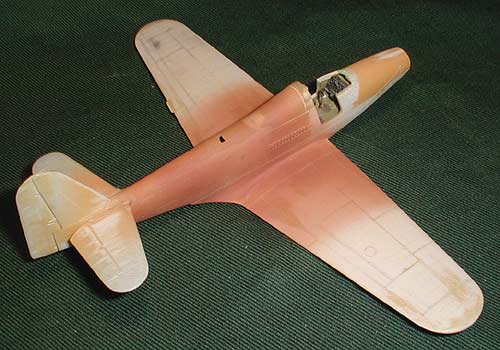| Toko RP-63G Pinball |
| |
 |
|
| Like many people who slap bits of plastic together in an attempt
to form scale models of full size objects, I have a great propensity towards
starting kits but am severely lacking when it comes to actually finishing
them. Very often, like this P-63, it will be the most trivial of tasks that
stops me dead in my tracks and results in the model languishing in its box
for several months/years/decades. In this case it was the minor task of
re-scribing the panel lines around the wing roots which were obliterated
during the filling and sanding stage that caused me to lose interest for
a couple of years. At the moment however, I'm doing my very best to finish
off all the old projects which have been sitting about for far too long
before starting something new and the P-63 is the latest beneficiary of
this policy. And it took all of five minutes a side to re-scribe those wing
roots when I finally got around to finishing the kit. D'oh!! |
| |
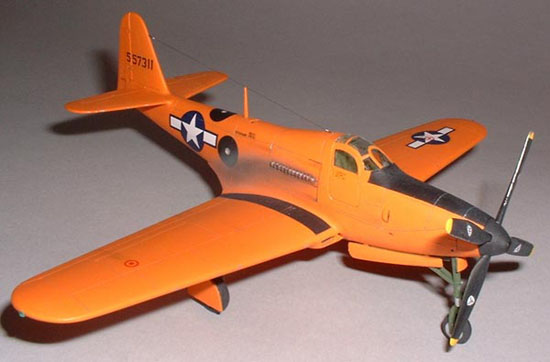 |
|
| This isn't a horrendous kit but it isn't the best you'll come
across either. Fit was mediocre to poor in most cases, trailing edges of
the wings needed a great deal of scraping to thin them down and the engraved
detail was very hit and miss. I ended up re-scribing most of the kit because
so much was lost filling the seams and what was left was very inconsistent
anyway. Clear parts are rather thick but fairly clear and a dip in Klear/Future
improved them even more. |
| |
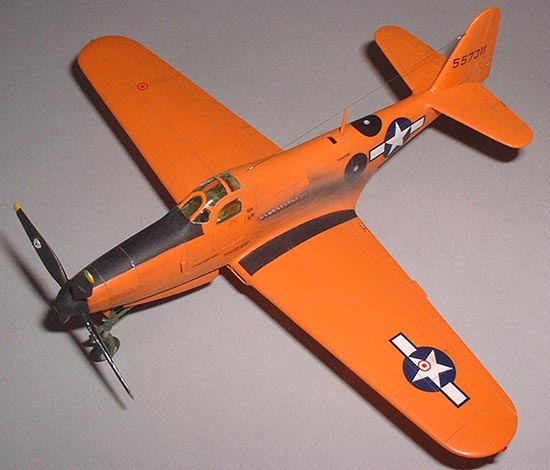 |
|
| Another issue concerns the stance of the aircraft. P-63s tended
to sit very nose high on the ground with the bottom rear of the fuselage
almost parallel to the ground. Toko's Kingcobra sits pretty much level although
the close up pictures tend to give it an exaggerated nose high look. The
problem is that the front forks aren't long enough and the main gear oleos
aren't compressed enough. Neither would have been difficult to fix had I
noticed it in time and if I was really bothered about it. It looks like
a P-63 and that's close enough for me. |
| |
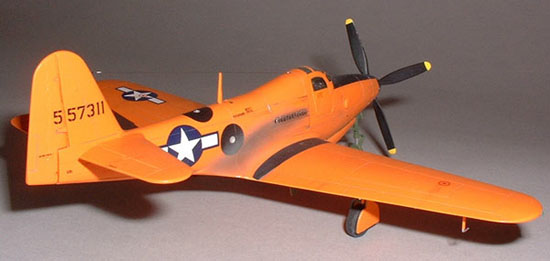 |
|
There are differing opinions concerning the colour of these
flying targets. The P-39/P-63 "Detail & Scale" says orange/yellow
and the colour profile in both it and the "In Action" book are
in this colour. The January 1998 issue of "Scale Aircraft Modelling"
says international orange and the Air Force Museum's restored RP-63 has
been finished in that colour. My own personal belief is that since this
aircraft comes from the same stable and era as the Bell X-1 it would have
been painted the same "pumpkin orange" colour which is somewhat
lighter and not quite as intense as international orange. There is a contemporary
colour photo of a flight of Pinballs in the aforementioned SAM that does
seem to show them as a pale orange, though the picture quality is quite
poor so there is a lot of room for interpretation. I painted mine with Humbrol
orange with some yellow and white thrown in to lighten it up a bit.
The USAF's aircraft has the gear legs painted black which I think is incorrect.
Black and white pictures show the nose gear leg at least to be noticeably
lighter than the anti-glare panel and propellor and I think it's much more
likely that the gear legs were painted in "Bell Green" like the
P-39. |
| |
 |
|
Toko's decals weren't bad but they were almost completely
impervious to setting solutions. The stars and bars were strangely proportioned
so I replaced them with some Superscale ones. Stencils are from the spares
box. I rearranged the kit serial numbers to model 557311, just to be a bit
different. Note also that the "Pinball Do Not Tilt" markings belong
on an RP-63A which had a different style of dorsal intake not supplied in
the kit.
I didn't care much for the white dots in the centre of the black circles
that were supposed to represent the flashing lights (thus the "pinball"
name). I used an eighth inch drill bit to drill shallow holes where the
white dots were and then painted them silver. When that was dry I filled
the holes with 5 minute epoxy and had nice clear lights that are a big improvement.
The light in the spinner is the kit part, polished and backed up with a
bit of Bare Metal Foil.
Photos showed these things to be quite dirty with a lot of exhaust staining
so I used my usual mix of Polyscale grimey black and clear flat for the
exhaust stains and finished up with pastels for other miscellaneous dirt.
Paint chips are Metalizer aluminum. RP-63s had two pitot tubes (I'm assuming
one was a backup in case the other got shot off) and these were made from
brass rod and scrap plastic. |
| |
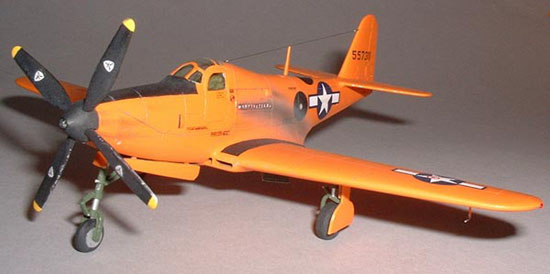 |
|
| |
|
|
| |
| |
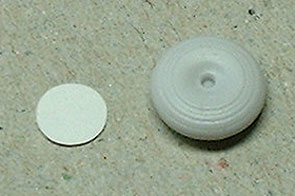
|
Left:
Nosewheel had a nasty sink mark on one side so this was covered with
a disc of .005" card. |
|
|
| |
 Back
to 1/72 Aircraft Main Back
to 1/72 Aircraft Main |
| |






